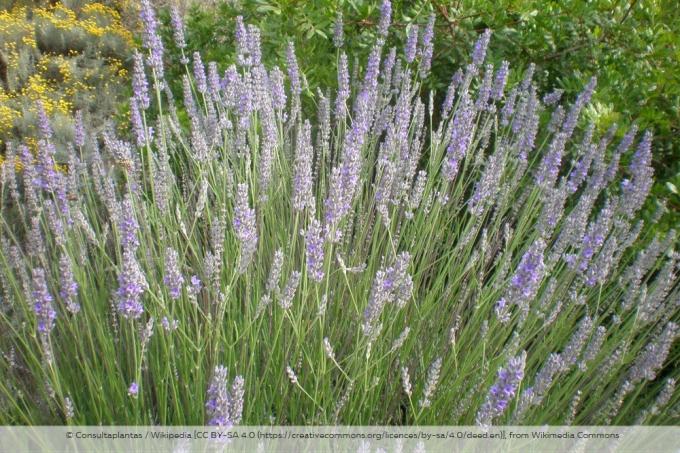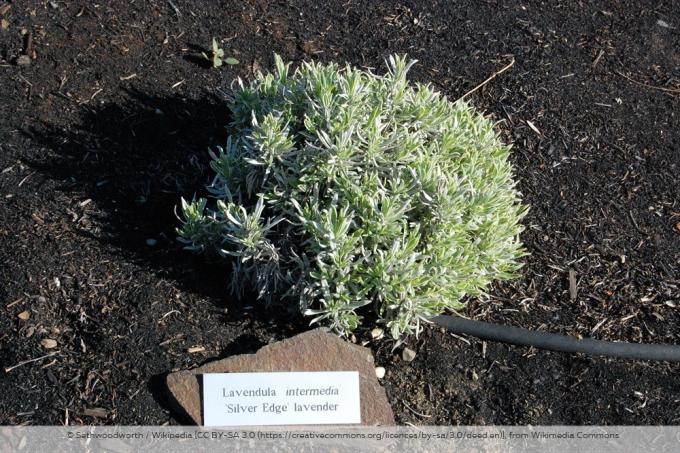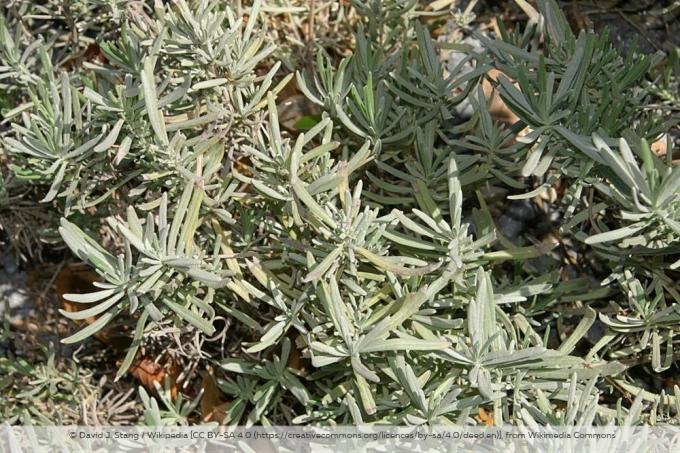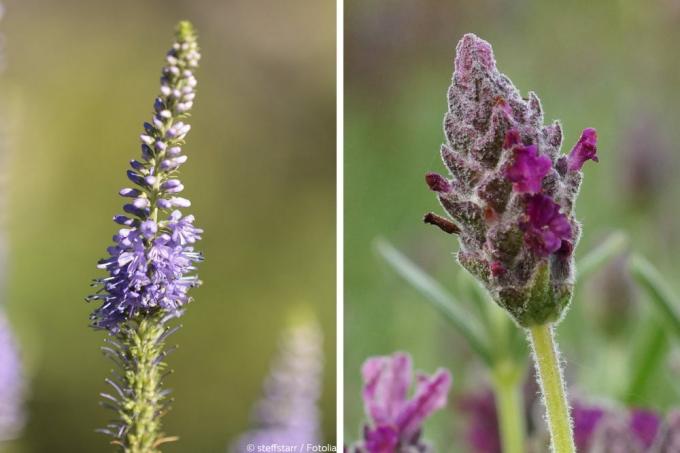
table of contents
- Characteristics
- Care instructions
- Location
- Soil and substrate
- plants
- In the bed
- In the bucket
- to water
- Fertilize
- Cut
- Overwinter
- Multiply
- Differences from lavender
Profile and care information open +conclude -
- Flower color
- pink, purple, white
- Location
- Absunnig, sunny, full sun
- Heyday
- July August
- Growth habit
- bushy, subshrub
- height
- up to 1 m high
- Soil type
- sandy, loamy, gritty
- Soil moisture
- moderately dry, fresh
- PH value
- neutral, alkaline
- Limescale tolerance
- Calcium tolerant
- humus
- rich in humus
- Poisonous
- no
- Plant families
- Mint family, Labiatae, Lamiaceae
- Plant species
- Container plants, bedding plants, balcony plants
- Garden style
- Rock garden, gravel garden, winter garden
Lavandin is certainly not a dirty plagiarism of real lavender. In fact, Lavandula Intermedia trumps the pure species in terms of abundance of flowers, fragrance experience and modest demands. This guide sheds light on the differences between the two plants and reveals characteristics of Provence lavender that are suitable for gardening. A tried and tested guide to care removes all doubts that give home gardeners headaches when it comes to cultivation.
Characteristics
- Plant family: Mint family (Lamiaceae)
- Genus: Lavender (Lavendula)
- Name of the species: Lavandin (Lavandula intermedia)
- Common name: Provence lavender
- Central distribution area: Southern France, Provence
- Habit: evergreen, bushy, branched subshrub with a height of 70 to 100 cm
- Flower: purple-blue, white or pink flower spikes, 5 to 10 cm tall
- Flowering period: July and August
- Location: full sun, sunny to shady, preferably rock garden, gravel bed and tubs
- Soil type: sandy-loamy to sandy-gravelly, fresh to dry
- Lime tolerance: very good, pronounced lime requirement for vital growth
- PH value: neutral to alkaline value from 6.5 to 8.0
- Winter hardiness: hardy up to - 17.3 degrees Celsius (winter hardiness zone 6)
- Toxic: no
- Use: rock gardens, gravel beds, open fields with wild shrub character, tubs, cut flowers, dried flowers
Lavandin is a natural hybrid of real lavender (Lavandula angustifolia) and broad-leaved lavender (Lavandula latifolia), also known as Speik lavender and Spiced lavender. The natural hybrid was the inspiration for the magnificent cultivars that characterize the landscape of Provence today and exude Mediterranean flair in private ornamental gardens.
Care instructions
The discovery of the natural hybrid Lavandula Intermedia was not only a stroke of luck for the impoverished Provence in the south of France, because the production of valuable lavandin oil rose to unimagined heights. The resulting varieties such as 'Edelweiss', 'Grappenhall' or 'Grosso' transform gardens north of the Alps into a Mediterranean fairy tale of colors and the scent of flowers. The following instructions will (hopefully) provide convincing proof that the successful care of Lavandin can also be mastered without any problems for beginners in hobby gardening.
Location

The careful choice of location makes a significant contribution to vital growth, lavish abundance of flowers and a bewitching fragrance. If Lavandin finds the following conditions in the bed and on the balcony, the maintenance effort is reduced to a minimum:
- Full sun to shady location
- Ideally, at least 6 hours of sunshine a day during the growth and flowering period
- Warm and sheltered from the wind
In regions prone to late frost, however, a place near a protective wall or hedge is recommended. For cultivation within winter hardiness zones 4 or 5, Lavandula Intermedia is only suitable in a bucket so that it can spend the cold season in winter quarters. Gardeners should take this premise to heart, especially in the low mountain ranges or in the southeast of Bavaria and wherever the thermometer can drop below -20 degrees in winter.
Soil and substrate
When the sun and warmth pamper the above-ground parts of the plant, the roots in the ground must not go empty-handed. Because only a balanced combination of light conditions and soil quality elicits the optimum from a Lavandula Intermedia. This earth wants a Provence lavender:
- Sandy-light to humus-loose
- Calcareous, preferably with a neutral to alkaline pH of 6.5 to 8.0
- Gladly dry to fresh, without the risk of waterlogging
- Low nutrient content, mainly low nitrogen
- Well-suited pail substrate: herb soil, pricking soil, mix of sand and potting soil in equal parts
The most important thing when it comes to substrate quality is a lean, permeable composition. Of course, Lavandin cannot completely do without nitrogen as a growth engine. However, an excess of this nutrient reduces winter hardiness drastically. At the same time, leaf growth is encouraged, while the picturesque abundance of flowers falls short of expectations. In the later section on the subject of fertilization, we will again devote ourselves to this aspect of care in detail.
plants
As the parent plant, Speiklavender (Lavandula latifolia) is responsible for the limited winter hardiness of its descendant Lavandin. The planting time in spring also takes this into account. If the young plants are only planted in autumn, the time window until the first frost is open too short to ensure sufficient rooting at the site. We therefore recommend planting young Lavandula intermedia in April or May, as long as there is no longer any fear of frost.
In the bed
With the right choice of location, soil conditions and planting time, far more than half the way is now covered for the perfect planting of Lavandin. Give the bed soil your attention beforehand by removing weeds, old roots and thick stones. If you have concerns about permeability, mix in a few handfuls of quartz sand or fine gravel. The lime content in these aggregates is beneficial for all types of Lavandin. Sour soil with a pH value of less than 6.5 can be optimized with a well-measured dose of garden lime. How to plant Lavandula Intermedia with horticultural expertise:
- Place potted root balls in water until no more air bubbles rise
- Dig the appropriate number of planting pits at a distance of 30 to 35 cm
- Now pot the plants and place them in the middle of the soil
- Press the earth on with your hands and water
- Finally, mulch the planting site with white pebbles or light sand (no dark bark mulch)
The previous planting depth of Lavandin in the nursery pot should be retained. Young plants that are too deeply planted suffer from a lack of oxygen at their roots. Root balls planted too high, on the other hand, lose their stability and therefore find it difficult to take root in the ground.

In the bucket
Planting lavandin in the tub largely follows the flow in the bed. In addition, lay out a few potsherds or expanded clay balls on the bottom of the vessel as a water-bearing layer. So that the substrate does not clog up this drainage later, simply place an air and water-permeable fleece between them. Please do not fill the soil to the outermost edge of the bucket. A distance of 2 cm prevents irrigation or rainwater from spilling over.
to water
Lavandin's preference for dry conditions reduces the additional water supply to a minimum. In the bed, the normal occurrence of rain and morning dew therefore covers the need for water well. If summer comes with high temperatures and lots of sunshine, please check the condition of the bed soil with a thumb test every week. If you do not feel any moisture at a depth of 2 to 3 cm, watering will take place. Let the water jet from the pot nozzle run directly onto the root disc so that the flowers and leaves stay dry.
Lavandin in the tub is denied access to the water reserves in the garden soil. The sunnier and warmer the location, the higher the evaporation rate turns out to be. Regular finger tests in the early morning therefore reveal whether the plant would like to be watered.
Fertilize
In the maintenance of Lavandula Intermedia, fertilization is of secondary importance. Normal garden soil naturally contains all the important nutrients to cover the low demand. The one-time gift of garden or algae lime at the start of the season is beneficial for vitality, abundance of flowers and the fragrance experience. If you mulch lavandin with sand or gravel, there is no need to use additional fertilizer with lime.
Fertilizing in pots is also not part of the Lavandula Intermedia maintenance program. By repotting the plant in fresh substrate every one to two years, the supply of nutrients is guaranteed.
Cut
As an evergreen subshrub, lavandin tends to lignify and bleach from its base. In order to counteract this tendency, regular pruning plays a key role in professional care. Commercially available rose or box tree shears and short hedge shears are ideal for this. It is cut twice a year with different thicknesses. The main pruning takes place in early spring, after the last frost and in good time before the fresh budding. The time window for the maintenance pruning opens at the end of the flowering period. How to Properly Cut Lavandula Intermedia:
- Main cut: cut back all shoots by half to two thirds
- After flowering: cut off all withered inflorescences
- Pruning: the younger the plant, the deeper the shoots in the herbaceous area
- Shaping: ideally cut spherical or pillow-shaped
The 3 most common mistakes when cutting lavandin are: cutting too deep into old wood, cutting too early or too late an appointment for the main cut as well as a too late maintenance cut in the summer after the first Half of August.
Overwinter

A planting time in spring is not enough for successful wintering in beds and tubs. The limited winter hardiness of Lavandin requires further precautions so that the Mediterranean plant does not fall victim to frost and permanent winter wetness. How to skilfully guide Lavandula Intermedia through the cold season:
Winter protection
- In the bed: pile up leaves and brushwood on the root disc or cover with fleece
- Alternatively: excavate, pot in a mixture of soil and sand and overwinter frost-free
- In the bucket: place on wood in the partially shaded, rain-protected place, cover with bubble wrap and coconut mats
- Alternatively: put in a light, frost-free winter quarters
Winter care
- Do not cut any more from the second half of August
- Water from time to time in the bed in sunny, dry winter weather
- Water regularly in the pot in the dry location so that the root ball does not dry out
The most common mistakes when wintering lavandin start in summer. Excessive watering, fertilizing with nitrogen and cutting the flowers too late also impair the already limited winter hardiness.
Multiply
As a sterile natural hybrid, Lavandula Intermedia does not form seed heads after its flowers have been fertilized. The cuttings method is therefore ideal for the offspring of other plants. The vegetative form of reproduction is not just easy to carry out. In addition, it is guaranteed that the young plants have the same wonderful properties of their mother plants. How to properly apply the method:
- The best time is between May and August
- Unwooded, non-flowering head shoots cut 10 to 15 cm in length
- Remove leaves and buds in the lower area
- Fill propagation boxes or pots with potting soil or coconut humus
- Then insert two thirds of the cuttings and water
For the first 4 to 8 weeks, place the cuttings in a warm, partially shaded location. Only when a fresh shoot indicates that the rooting is successful, the relocation takes place in a sunny place. Water your pupils regularly and do not give fertilizers. Throughout winter, the young Lavandula intermedia linger in the bright, frost-free window seat until the planting season begins in spring.
Differences from lavender

Lavandin was discovered as a natural hybrid back in the early 19th Century by the French doctor and botanist Jean-Louis-Auguste Loiseleur-Deslongchamps. However, the triumphant advance of the flowering subshrub only really took off at the beginning of the 20th century. Century its outstanding advantages over the pure species and parent plant Lavandula angustifolia became apparent. The focus was on economic interests, because lavandin is significantly more productive for the production of the coveted lavender oil. 30 to 40 kg of lavandin flowers are enough to produce 1 kg of lavandin oil. In contrast, a whopping 150 to 170 kg of lavender flowers have to be harvested for the same amount.
For hobby gardeners, decorative aspects and modest demands on care also play a decisive role when comparing the two types of plants. The following overview summarizes essential differences to lavender from the point of view of lavandin:
- Up to 30 percent longer shoots
- Higher bud and flower density
- More intense scent in the bed, on the balcony and for room scenting
- Later flowering time with reduced risk of late frost damage in rough locations
- Lower healing power due to lower concentration of essential oils
- As a sterile hybrid, does not produce seeds for propagation by sowing
- Less winter hardiness than Lavandula angustifolia
- More sensitive to improper pruning at the wrong time



